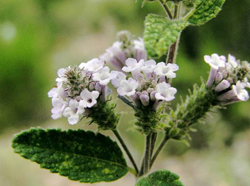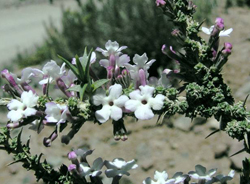|
When Hannah Marx started school at the University of Washington, she thought about going into medicine; but an international health seminar she took shifted her thinking from practicing medicine to research. Interested in many things and not yet ready to narrow her focus, Hannah took a plant identification and classification class and realized how much she enjoyed learning about plants. “Plants seemed to be a relatively unexplored domain where more research could be done,” Hannah said. And research was exactly what she wanted to start doing, so she went to work in Biology professor Richard Olmstead’s lab.
The Olmstead Lab studies plant systematics and all members of the lab warmly welcomed Hannah. She’s working with Biology graduate student Yaowu Yuan on resolving the phylogeny, or family tree, of the Verbena family, Verbenaceae, which is closely related to the mint family. The Verbenaceae is native to South America and is most diverse on that continent. Verbena is a common ornamental plant and lemon verbena (actually not a Verbena species at all, but Aloysia citriodora) a medicinal herb used as a digestive aid and culinary herb used in teas and baking.
Historically plant families were organized based on morphological characters. But traditional classifications are often discordant with data gathered using modern molecular methods. To help sort out the organization disparity in the Verbenaceae, Hannah was awarded a Mary Gates Research Scholarship to sequence two chloroplast genes and one nuclear gene. With the data she collects, she should be able to resolve the broader tribal classifications within the family. Further work by Yuan and Pat Lu-Irving, another Biology graduate student, will help clarify relationships on a finer scale. Yuan is working on the tribe within the family known as the Verbena complex and Pat is working on the Lantana complex.
|
DNA for sequencing comes from a variety of sources. Some plant specimens were collected in South America by members of the lab, others come from herbariums around the world. Extracting DNA from herbarium specimens is a bit like forensic work. “Whether DNA can be extracted successfully depends wholly upon how the specimen was prepared and preserved,” Hannah explained. “I’ve recovered DNA from a specimen collected more than 50 years ago, but was unable to extract anything from a plant pressed 10 years ago.”
Presently Hannah has started the application process for a Fulbright Scholarship. If she is awarded one, she plans to travel to South America to further her work on this project. She thinks it would be interesting to combine molecular data with morphological and even geographical data onto a single family tree depicting traits. However, she says it’s difficult to know what might be most useful or applicable without first collaborating with some of the Verbenaceae experts in Argentina.
Currently Hannah is also volunteering at a community center that teaches Internet and computer skills to immigrants through a program developed by another Mary Gates Scholar, Sandra Levva. The program was initiated at the request of Latino immigrants who want to learn how to use the Internet to discover opportunities available to them. Needless to say, they are all eager to learn as much as possible. They also take the opportunity to practice speaking English, while Hannah takes the opportunity to strengthen her Spanish.
|
In addition to majoring in plant biology, Hannah is minoring in dance. At the end of winter quarter she is performing for the third time in her undergraduate career. Dance majors are required to put on a performance in order to graduate and are responsible for all components of the piece, including choreography, costumes, lighting, and music. All three of Hannah’s performances have been in dances orchestrated by majors. “Performing in pieces composed by dance majors is fun because each piece is so fresh,” Hannah said. “And the process is very collaborative.” For Hannah, dance is a way to exercise the right side of her brain. She enjoys it as a complement to science, though wonders how she might combine the two.
Although Hannah hasn’t decided what she wants to do after she graduates, her commitment to research has a solid foundation: Her younger brother was diagnosed with a rare form of abdominal cancer about a year ago and following treatment has (thankfully) gone into remission. His attitude toward life and living with cancer has been an incredible source of inspiration to Hannah in more ways than one. She puts it quite bluntly when she says her brother would not be here if it weren’t for research. And while her research doesn’t pertain directly to curing cancer, her belief in the importance of basic biological research is rock solid. After all, applied research begins with the discoveries of basic research.





